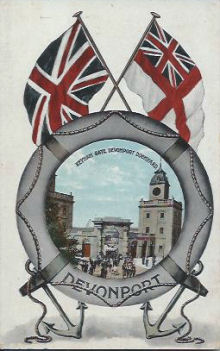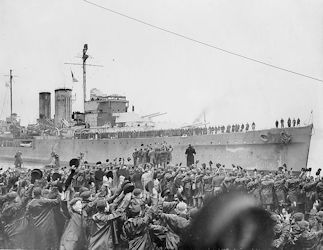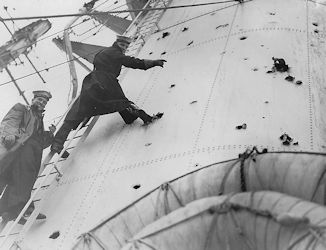|
OLD DEVONPORT
. UK |
||
|
© Brian
Moseley, Plymouth Webpage created: February 02, 2016 Webpage updated: April 24, 2023 |
||
|
- THE ROYAL NAVY IN OLD DEVONPORT
From a postcard. Although the Royal Navy had been present in the Plymouth area for centuries, they had only used Plymouth Sound or Barn Pool, off Cremyll, for mooring and the Cattewater for repairing and cleaning their vessels. The Admiralty set up a Naval Victualling Office on the Barbican at Plymouth to supply their warships and feed their sailors. It was not until the French opened a naval dockyard across the English Channel at Brest that a need was seen for an English equivalent and the Hamoaze, between Devon and Cornwall, was seen as the ideal location. The first stone dock was built at Point Froward in the Hamoaze in 1691 and over the next three centuries the Royal Navy took over the whole of the waterfront from Devil's Point (Royal William Victualling Yard) through the Gun Wharf, the Keyham Steam Yard, the North Yard Extension, and the Royal Naval Barracks, until it eventually engulfed reclaimed land for the Royal Naval Armament Depot at Ernesettle. In charge of all the Royal Navy establishments from Exmouth westwards to Penzance was the Commander-in-Chief, Plymouth Command (except between 1845 and 1896, when it was Commander-in-Chief, Devonport) until that post was discontinued in 1970. In 1939 that post was held by Admiral Sir Martin Eric Dunbar-Nasmith VC KCB. Under his command came the Admiral-Superintendent of the Royal Dockyard, a post held in 1939 by Rear-Admiral Arthur N Dowding CB; the Commodore of the Royal Naval Barracks, Rear-Admiral A T B Curteis; the Surgeon-Rear-Admiral of the Royal Naval Hospital at East Stonehouse (Surgeon-Rear-Admiral G F Synms FRCS LRCP); the Engineer-Captain in Charge of the Royal Naval Engineering College (Commander (Engineering) W L Spear; the Captain in Charge of the Royal Naval College, HMS "Britannia" at Dartmouth (Captain F H G Dalrymple-Hamilton) and the Commandant of the Plymouth Division, Royal Marines, equivalent to a Royal Naval Commodore, at the Royal Marine Barracks, East Stonehouse, which in 1939 was Brigadier Harold George Grant. Over those three hundred years and more the Royal Navy establishment in Devonport, under the Commander-in-Chief at Admiralty House (1795), Mount Wise, now an extinct posting, has been composed of: -
These were joined in June 1939 by the Women's Royal Naval Service, Plymouth Command. In addition to the these Royal Navy establishments, the Board of Ordnance, which was a military body allied to the Royal Artillery and the Royal Engineers, supplied gunpowder to both the Army and the Royal Navy. Prior to the coming of the Royal Naval Ordnance depots the Board of Ordnance operated the Powder Magazine at Keyham Point (1784) and the Powder Kilns at Bull Point, Saint Budeaux, After receiving considerable damage during the Battle of the River Plate, HMS "Exeter" arrived back at her home port of Devonport at around 8am on Thursday February 15th 1940, to be welcomed by the First Sea Lord, Mr Winston Churchill.
HMS "Exeter" returns to Devonport Dockyard
after the Battle of the River Plate.
A sailor points out the shell holes on the
funnel of HMS "Exeter". Navy Week was first held in 1928 and was repeated in 1929, 1930, 1931, 1932, 1933, 1934, and 1935, after which there was a break until 1938, the last one before the Second World War (1939-1945). When the event recommenced in May 1948 it had been reduced to Navy Days. A familiar sight in the 1960s was the monitor HMS "Roberts", moored off Saltash Passage with her big guns pointing at the Royal Albert Bridge. No longer is a Commander-in-Chief in charge of the Royal Navy at Plymouth, or an Admiral-Superintendent head of the Royal Dockyard. Even the officer in charge of the Royal Naval Barracks has been demoted from Commodore to Commander.
|
||


